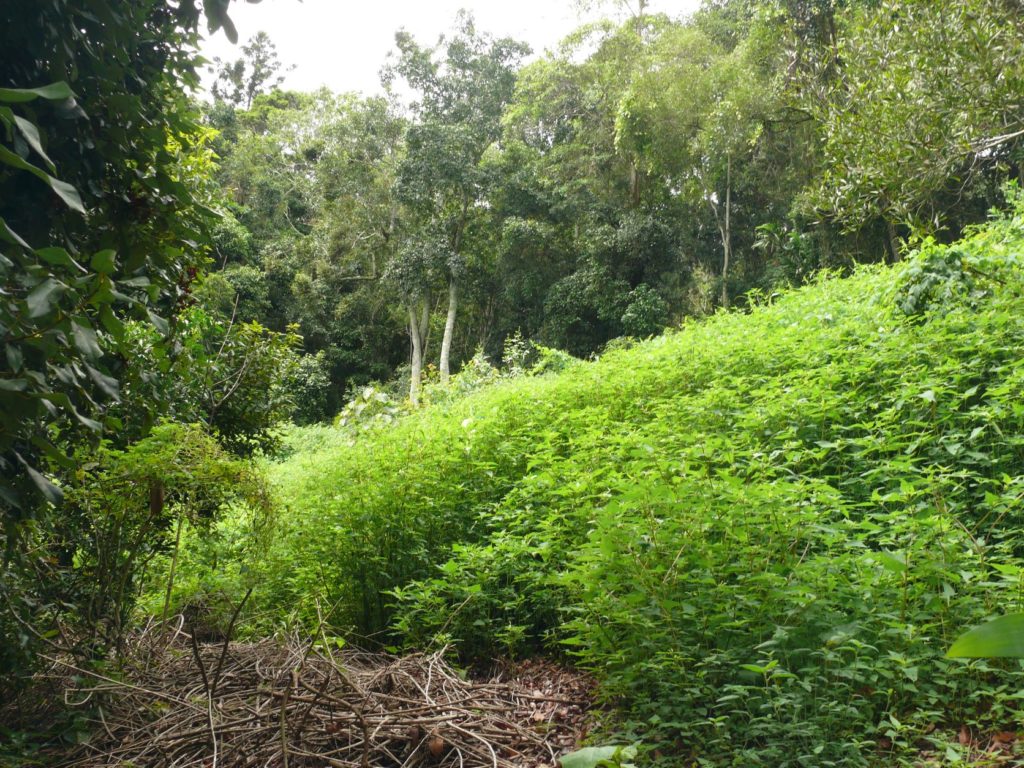Protected Magazine
Jolly’s Lookout Weed Clearing
This is a conservation story about longevity, consistency, leadership and determination.
I often reflect—is conservation about a feeling, an ideal, or an action? Well, in this story, it’s all three. As humans, many of us have an emotional connection with nature that drives conservation tendencies and actions.
Interestingly, the word ‘conservation’ is a noun (a place, a thing etc.) whereas the word ‘conserve’ is a verb (doing something). The characters in this story are the doers. They have tremendous energy and commitment, some turning up monthly for 25 to 30 plus years. This equates to 300 or more visits to the mountain in times of drought or flood for some of these long-term volunteers!
The Jolly’s Lookout bush regeneration project started with grand Lantana-pulling sessions in 1986. Honorary protectors, along with some NPAQ members, were led by QPWS rangers Wil Buch and John Ravenscroft. They undertook an initial project area between Boombana and the Mount Nebo village, restoring degraded areas using the Bradley method bush regeneration technique.
NPAQ ramped up their presence in 1990 to celebrate the association’s 60th anniversary and support their national park advocacy role with a hands-on activity in the park. In 2005, NPAQ activities moved to the Egernia circuit at Jollys Lookout, again targeting Lantana in the understory with many large thickets being removed, though this group isn’t fussy—they’ll remove any weeds that happen to pop their heads above ground! The Thylogale walking track became the focus in 2010 with more challenging Lantana infestations to tackle.
Lantana has been the key offender in the decline of native species, invading when the ground was disturbed during early settlement, logging and, in some locations, subsistence farming. The NPAQ technique has been hand removal, which includes removing the root system and following up with re-treatments for months and years afterwards, with some astonishing results. Areas previously dominated by Lantana have regenerated with native ferns, ground covers and mid-story species. Photo monitoring plots set up over time have catalogued the changes in recovery.
The ecosystems around Jollys Lookout and Boombana are made up of rainforest and wet sclerophyll forest, with flagship species like Brown Pine Podocarpus elatus and Lacebark Brachychiton discolour. The contribution of the volunteers assists in protecting many plant and animal species.
In more recent years, there have been multiple challenges that include difficulty in recruiting new volunteers and enduring significant droughts and bumper wet seasons. Despite these challenges, the current work area is targeting perhaps the biggest area of Lantana invasion to date, where steep scree slopes make removal even more challenging. Angus and the crew (somewhat ironically) call this ‘the last major thicket’.
Like most volunteer groups, there is a core of long-term, dedicated individuals that keep the show on the road. It’s important to recognise the great contribution these members have made to the conservation project over the years, and without their commitment the project wouldn’t have been possible. We mustn’t forget the great efforts that all the other volunteers make by supporting the main activity with shorter bursts of enthusiasm that keeps things ticking along.
Some key contributors to the project more recently include: Angus McElnea (current co-ordinator who began work in 1994), Russell Gardner since June 1990, John Nowill since 2005. Some earlier project stalwarts that contributed greatly to the success include Ruth Read, Helen Lucas, Ken Sandercoe, Dawn Vance, Don Cumming, Heatherbell Mellor, Len & Nola Frazer, and more recently Lorraine Best and Ian Peacock.
I had a chat with Angus prior to preparing this article about the NPAQ project, and I asked him about what motivates him, and what are some key benefits and milestones. Here’s some of what he said:
It’s a beautiful place to work with views out to the bay islands. I enjoy working with a great group of people where friendships are forged. Some students do their Duke of Edinburgh award volunteer element using the project and first year ecology UQ students walk the trails annually as part of their botany/ecology studies. It’s a breeding ground for volunteers and new rangers. Another highlight was in 1995 when The National Trust presented NPAQ with a John Herbert Award for the Boombana bush regeneration project.
QPWS passes on its gratitude and thanks to NPAQ for coordinating the project over many years. Examples like these help to drive and motivate our own local staff to achieve great results for conservation.


